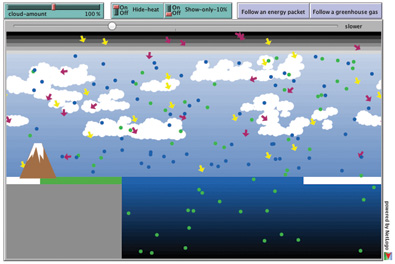News at Concord Consortium

Students significantly improved their scientific argumentation ability and understanding of Earth and space science using High-Adventure Science curriculum units. A new project—High-Adventure Science: Earth’s Systems and Sustainability—builds on these promising findings, thanks to the National Science Foundation.
We are partnering with the University of California, Santa Cruz and the National Geographic Society to develop units for middle and high school students on climate change, fresh water availability, fossil fuel utilization, resource sustainability and land use management. We will test the hypothesis that students who use computational models, analyze real-world data and engage in scientific reasoning will be better able to understand how humans affect Earth’s systems.
Read more about High-Adventure Science.
- “Modeling Climate Change,” The Science Teacher, October 2012
- “Exploring the Unknown,” The Science Teacher, March 2012
Geniverse and Whyville Combine Forces
Can the intersection of school and social media transform STEM learning? With funding from the National Science Foundation, our Geniverse software and the Whyville virtual world are teaming up to explore this question.
Geniverse games have demonstrated that interactive technology is effective for teaching genetics in the classroom. Whyville has more than 7 million registered users from around the world, most between 8 and 15 years old, two-thirds of them girls. Their “learning by doing” approach to STEM education encourages children to engage in authentic scientific inquiry in an informal, collaborative setting. We’ll introduce Whyville users to our genetics games and research the effect of combining technologies intended for formal and informal learning.
Graph Literacy for Middle School Students
For success in math and science courses students should be able to identify the important features of a wide variety of graphs and relate those features to the context of the graphs. Thanks to the National Science Foundation, we are using our powerful SmartGraphs software to develop and pilot test activities and assessments to improve student graph comprehension. We are focused on scatter and line graphs and will test these activities with students in grades 7 and 8 in Maine, which has a 1:1 middle school laptop program.
K-2 Students Are Sensing Science
Heat and temperature are both abstract and invisible, but real-time visualizations linked to probes and sensors have shown great promise in aiding students as young as third grade in understanding these ideas. A new project, funded by the National Science Foundation, is developing innovative remote sensing technology and curriculum units for K-2 students. Activities focus on children’s physical and tactile experiences of heat and temperature in the everyday world. Research will focus on student preconceptions and the role of well-designed curriculum and software in improving science teaching and learning in K-2 classrooms.
Back to School Webcast with Chad Dorsey
In a live webcast on November 14, 2012, from 7:30 – 8:30 p.m. (EDT), Chad Dorsey will introduce scientific and engineering practices from the Next Generation Science Standards and describe how free, technology-based activities can support students. Please put this event on your calendar now and register at concord.org/webcasts. We’ll send a reminder before the webcast.
Like Us, Follow Us
We’re thrilled to have you as friends and followers. Get the latest updates on happenings at the Concord Consortium by following us on these sites.
